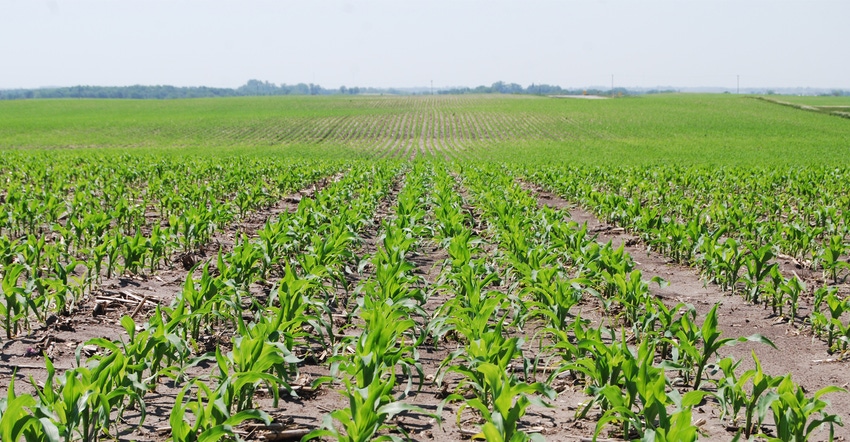June 13, 2019

Last month I reported it had been a somewhat uneven start to the 2019 crop year. Never did I think I’d report a month later in this same column that due to continued cold, wet planting conditions, we still haven’t finished planting our corn or soybean crops here in the Midwest!
The eastern Corn Belt, in particular, has suffered from poorer overall conditions, as farmers in Illinois, Indiana and Ohio fell well behind the progress that was achieved in the western Corn Belt. With that said, it is important to note that almost no one has had an overly smooth 2019 planting season; and, as of this writing in early June, there is still much to do.
With this year’s historically late spring planting season, farmland sales have somewhat taken a back seat. This is normal for the market to pause, as field activities take center stage. Coming into spring, Iowa (and Midwest) farmland values were largely stable. Selling best were farms with above-average soil types, adequate drainage, easy farm-ability and well-managed fertility levels.
These qualities are more pronounced with the struggles of the 2019 growing season bringing to light the real differences between farms. Even in the face of much uncertainty this spring, farmers were buying nearly 8 out of every 10 farms brought to the market, although non-farming investors have been an active and influential buying segment in most corners of Iowa for quality row crop farms.
The farmland market reflects the collective confidence of all participants in the market. When things are going well, farmland values tend to be stable to higher, while weakness in land values shows up when things are not working well. Locally speaking, there are always value differences when comparing one specific neighborhood to another. Localized growing conditions and local sale volumes are two areas to watch through the end of the year, given the major growing season differences this year. Those differences are likely to show up this fall in the land market.
Interest rates declining?
In the past 60 days, long-term interest rates have been drifting lower. A prominent Midwest lender told me that over the last 30 to 45 days, clients who had locked down long-term mortgage rates in 2018 were now refinancing to even lower rates.
So, while most short-term operating notes did reset to higher levels this past winter, rates on long-term mortgage products have again settled into a lower range than those of even six to nine months ago, which is supportive to land values.
In addition to lower interest rates, commodity markets will continue to be a major influencer in actual farm profitability, as well as the collective confidence of the Midwest land market. Huge early-season expectations for 2019 crops, coupled with massive ending stocks and an uncertain global trade situation, were pressuring the corn and soybean markets for the first four-and-a-half months of 2019. But when the trade realized the enormity of the problem with 2019 planting progress, markets began to react accordingly, and both corn and soybean prices have pushed appreciably higher in recent weeks.
Finally, the countryside is still working to maintain a hopeful and positive attitude regarding global trade negotiations. But fatigue is setting in. With the collapse of negotiations with China, positive attitudes are becoming more difficult to find. Luckily, the Trump administration’s threat to raise tariffs on Mexico if it didn’t do more to curb illegal immigration was resolved.
The outcome of these trade situations will absolutely impact commodity prices and underlying asset values, including farmland. It’s fair to say 2019 has quickly become one of those years that is sure to be discussed (and compared against) for years to come. As we grind deeper into the growing season, keep an eye on all these factors as they are sure to impact the land market in your local neighborhood.
NORTHWEST
Dickinson County. South of Terril, 80 acres recently sold at public auction for $7,000 per acre. The farm consists of 72 tillable acres, with an 80.3 CSR2 that equals $97 per CSR2 point on the tillable acres. This farm is divided by a drainage ditch, thereby separating the land into two tillable parcels.
NORTH CENTRAL
Hancock County. Near Forest City, 146 acres sold for $9,247 per acre. The farm has 145 tillable acres, with an 82.0 CSR2 that equals $114 per CSR2 point on the tillable acres.
NORTHEAST
Fayette County. Northwest of Wadena, 59 acres recently sold for $4,423 per acre. The farm consists of 59 tillable acres, with a 49.4 CSR2 that equals $90 per CSR2 point on the tillable acres.
WEST CENTRAL
Guthrie County. North of Adair, 80 acres recently sold in an online-only auction for $5,150 per acre. With 74 tillable acres and a 58.9 CSR2, this sale equals $94 per CSR2 point on the tillable acres.
CENTRAL
Marshall County. Southeast of Liscomb, 80 acres sold at public auction for $13,200 per acre. The farm consists of 78 tillable acres, with a 97.2 CSR2 that equals $139 per CSR2 point on the tillable acres.
EAST CENTRAL
Johnson County. West of Lone Tree, 93 acres sold for $7,450 per acre. The farm has 91 tillable acres, with a 66.9 CSR2 that equals $114 per CSR2 point on the tillable acres.
SOUTHWEST
Adams County. Northwest of Prescott, 77 acres recently sold at public auction for $4,100 per acre. The farm has 67 tillable acres, with a 57.1 CSR2 that equals $83 per CSR2 point on the tillable acres.
SOUTH CENTRAL
Madison County. Northwest of Lorimor, 117 acres sold at public auction for $6,100 per acre. With 109 tillable acres that have a 68.3 CSR2, this sale equals $96 per CSR2 point on the tillable acres.
SOUTHEAST
Wapello County. West of Packwood, 80 acres sold at public auction for $6,750 per acre. The farm has 68 tillable acres, with a 76.1 CSR2 that equals $104 per CSR2 point on the tillable acres.
Hensley is president of Hertz Real Estate Services, which compiled this list but did not handle all sales. Visit hertz.ag.
About the Author(s)
You May Also Like






